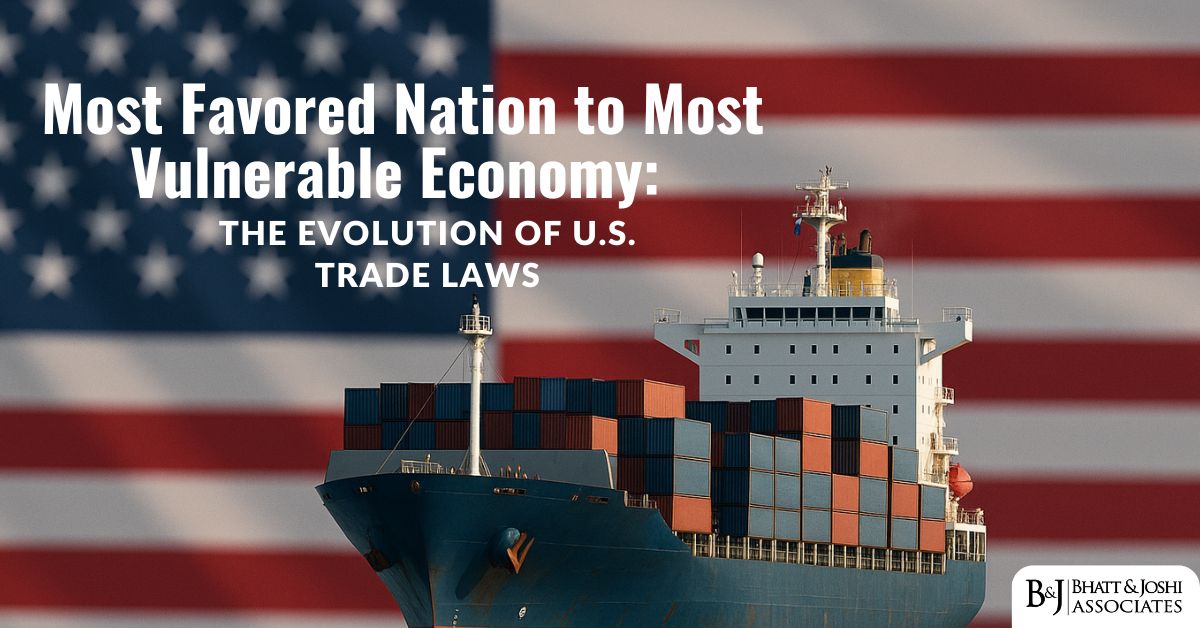Introduction
The transformation of U.S. trade law from a tool of economic dominance to a source of strategic vulnerability represents one of the most significant shifts in modern economic history. The Most Favored Nation (MFN) principle, later renamed “Permanent Normal Trade Relations” (PNTR) in U.S. law, began as a cornerstone of American trade policy designed to create a predictable, rules-based international trading system. However, this same principle has arguably contributed to America’s current economic vulnerabilities, particularly in its trade relationship with China and other emerging economies. This evolution reflects broader changes in the global economic order and raises fundamental questions about the effectiveness of traditional trade law frameworks in protecting national economic interests in the 21st century. Understanding this transformation is crucial for evaluating current trade policies, considering necessary reforms, and appreciating the evolution of U.S. trade laws in a shifting global landscape.
The Origins of Most Favored Nation Status
The concept of Most Favored Nation treatment has deep historical roots, dating back to 12th-century European maritime trade agreements. In U.S. trade law, it first appeared in the 1778 Treaty of Amity and Commerce with France, reflecting the young nation’s desire to ensure equal treatment in international commerce. This early adoption of MFN principles demonstrated America’s early commitment to fair and open trade relationships.
Section 251 of the Trade Act of 1974 later codified MFN principles in modern U.S. law, establishing it as a fundamental element of American trade policy. This codification represented the culmination of decades of trade law development aimed at creating a more open and predictable international trading system. The legal structure operates through several key mechanisms, including the Trade Act of 1974 (particularly Title IV), the Trade Agreements Act of 1979, the Uruguay Round Agreements Act of 1994, and various bilateral trade agreements and protocols.
The economic rationale for MFN treatment rests on solid theoretical foundations. It promotes trade efficiency through non-discrimination, reduces transaction costs in international commerce, creates stable and predictable trading relationships, and prevents trade diversion and market distortions. These principles helped shape a more integrated and efficient global trading system.
Post-WWII Implementation
The General Agreement on Tariffs and Trade (GATT) of 1947 enshrined MFN as a fundamental principle of the post-war trading system. Article I of GATT requires that any advantage granted by a contracting party to any product originating in or destined for any other country shall be accorded immediately and unconditionally to like products originating in or destined for all other contracting parties. This provision became the cornerstone of the post-war international trading system.
The Trade Act of 1974 marked a significant evolution of U.S. trade law, providing comprehensive reform that established authority for trade agreement negotiations, mechanisms for addressing unfair trade practices, a framework for granting and withdrawing MFN status, and the creation of “fast track” negotiating authority. These tools gave the United States significant flexibility in pursuing its trade objectives while maintaining consistent principles.
During the Cold War, MFN status evolved into a powerful tool of foreign policy through the Jackson-Vanik Amendment. This legislation linked MFN status to human rights and emigration policies, created annual review requirements for communist countries, and established congressional oversight of trade relations. This linkage between trade and broader foreign policy objectives would later influence U.S. approaches to China and other nations.
The Golden Age of American Trade Policy
The U.S. trade law system of the post-war era delivered remarkable benefits to the American economy. Through the 1970s, the United States maintained consistent trade surpluses, enjoyed unprecedented global market access for its products, and exercised leadership in setting international trade rules. This period also saw effective protection of strategic industries, allowing American companies to maintain technological advantages while building global market share.
The legal framework provided strategic benefits that extended far beyond pure economics. It gave the United States significant leverage over trading partners’ policies, allowed careful control over technology transfer, and provided substantial influence over international economic institutions. Perhaps most importantly, it helped support allied economies during the Cold War, strengthening the Western alliance through economic integration.
U.S. trade laws during this period became de facto global standards through various mechanisms. Bilateral trade agreements, the GATT framework, regional trade arrangements, and international investment treaties all reflected American priorities and legal principles. This created a coherent international trading system that generally operated to U.S. advantage.
China and the WTO Watershed
China’s WTO accession process (1986–2001) marked a crucial turning point in the evolution of U.S. trade laws, reflecting broader tensions between liberal trade ideals and geopolitical strategy. The negotiations led to the Permanent Normal Trade Relations legislation of 2000, established special safeguard provisions, created technology transfer agreements, and secured market access commitments. However, these arrangements would later prove inadequate for managing the complexities of U.S.-China economic relations.
The implementation of China’s WTO commitments revealed significant weaknesses in U.S. trade law. Enforcement mechanisms proved inadequate for addressing non-market practices, while protections against state subsidies and intellectual property theft were insufficient. These limitations became increasingly apparent as China’s economic power grew and its industrial policies became more sophisticated.
The granting of PNTR to China had several unforeseen consequences that continue to affect the U.S. economy. Rapid deindustrialization occurred in certain sectors as manufacturing shifted to China, while massive trade deficits accumulated. Technology transfer often exceeded intended limits, creating new competitors in strategic industries and exposing vulnerabilities in key economic sectors.
Modern Trade Challenges of U.S. Trade Laws
Current U.S. trade laws struggle to address several persistent challenges. The ongoing trade deficit issue encompasses not just bilateral imbalances but also concerns about currency manipulation, competition from state-owned enterprises, and the broader challenges of dealing with non-market economy practices. These issues have proven particularly difficult to address through traditional trade law mechanisms.
Recent developments have highlighted critical security vulnerabilities in U.S. trade relationships, underscoring how the evolution of U.S. trade laws must adapt to these emerging challenges. Supply chain dependencies, technology transfer risks, strategic industry erosion, and data security issues have all emerged as major concerns. These challenges have led to new protective measures, including Section 232 national security tariffs, Section 301 actions against China, expanded CFIUS oversight, and reformed export controls.
The Current State of U.S. Trade Laws
Recent legislative changes attempt to address these vulnerabilities through various initiatives. The CHIPS and Science Act of 2022, the Infrastructure Investment and Jobs Act, and various supply chain security measures represent efforts to strengthen domestic capabilities and reduce strategic vulnerabilities. However, these reforms must navigate inherent tensions between free trade principles and national security needs, global integration and domestic protection, and international commitments and national interests.
Current trade law contains significant contradictions that complicate policy implementation. The desire to maintain market access often conflicts with strategic industry protection needs, while global integration goals can clash with domestic economic security requirements. These tensions make it increasingly difficult to maintain consistent and effective trade policies.
Future Considerations of U.S. Trade Laws and Policy Reforms
Looking forward, several potential reforms merit consideration. Enhanced enforcement mechanisms, new defensive trade tools, strategic industry protection measures, and supply chain security initiatives all offer potential ways to address current challenges. However, implementing these reforms requires careful balance to avoid disrupting beneficial trade relationships.
Policy options for addressing current challenges include selective decoupling from strategic competitors, enhanced domestic production requirements, new alliance structures, and reformed trade remedy laws. Success in these efforts requires careful consideration of both economic and strategic implications.
Conclusion
The evolution of U.S. trade laws from instruments of economic dominance to potential sources of vulnerability reflects broader changes in the global economic order. The MFN/PNTR system, while successful in promoting trade liberalization, has proved inadequate in protecting U.S. economic interests against modern challenges, particularly from state-directed economies and strategic competitors.
Moving forward, U.S. trade law must evolve to balance multiple competing objectives: maintaining the benefits of international trade, protecting strategic economic interests, ensuring national security, promoting domestic industrial capability, and maintaining technological leadership. Success requires careful calibration of economic openness with strategic protections, and international engagement with domestic resilience.
The question is no longer whether the U.S. benefits from MFN policies in their traditional form, but how to reform trade laws to better serve national interests in a changed global economy. This may require fundamental rethinking of traditional approaches to trade regulation and the development of new legal tools better suited to current challenges. The future effectiveness of U.S. trade law will depend on its ability to adapt to new economic realities while preserving the core benefits of international trade.














